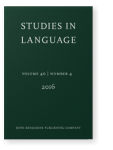Vol. 40:4 (2016) ► pp.815–871
Verbal inflectional morphology and modality in compound clause-linkage markers in Japanese
Japanese has many compound clause-linkage markers (hereafter “CLMs”). Some of them consist of a verbal inflectional suffix and (up to three) particles. They include eleven compound CLMs that have the Concessive conditional meaning (‘even if’) and/or the Concessive meaning (‘even though, although’). In these eleven compound CLMs, different inflectional categories of verbs (i.e. conjugational categories) combined with different particles indicate different degrees of the speaker’s belief or confidence regarding the likelihood of the existence or occurrence of a situation. That is, verbal inflectional morphology plays a crucial role in expressing modal meanings. Such a phenomenon does not seem to have been recognized for Japanese or any other language.
